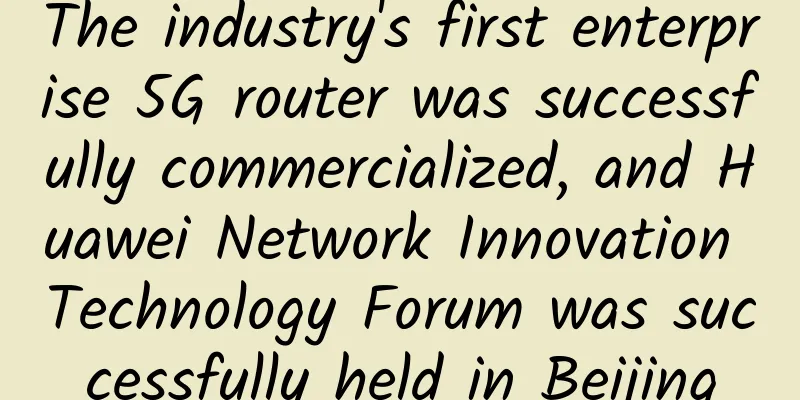In the F5G era, home broadband is moving towards Gigabit. Don’t let the optical modem hold you back.

|
Mobile networks have entered the 5G era, and their bandwidth, latency and other network capabilities will be multiplied, and services and business models will also undergo earth-shaking changes. So, what kind of changes will happen to fixed-line broadband, which has been developing in parallel with it for decades?
The development of new home broadband business has reached a turning point Do you remember 2003? That year, the SARS epidemic kept countless people at home, but it became a turning point for the accelerated development of China's Internet. JD.com and Taobao were both born in that year. The COVID-19 pandemic has affected the lives of billions of people around the world, but all signs indicate that it may change people’s online behavior unprecedentedly and accelerate the development of online business in the new era. After the outbreak, on February 4, the Ministry of Education issued the "Guiding Opinions on the Organization and Management of Online Teaching in Ordinary Colleges and Universities during the Epidemic Prevention and Control Period". Subsequently, various online platforms released a total of 24,000 online courses, and the number of people increased by 128 times. According to iMedia Research, the scale of the online education market has been growing year by year. In 2020, the scale of online education users in China will reach 309 million, and the market size is expected to reach 453.8 billion yuan. The demand for online remote work has also continued to explode. The number of WeLink daily meetings has doubled, and 10 million companies and 200 million users use Alibaba DingTalk for online work. According to iMedia Research data, during the 2020 Spring Festival, more than 18 million companies in China adopted online remote work, and a total of more than 300 million users used remote office applications, an increase of nearly 60 times compared to the number of users in 2018. The home quarantine mode has also accelerated the penetration of new businesses such as cloud VR. For example, according to statistics from South Korean operator LG U+, the traffic of VR videos, AR shopping, AR fitness and other businesses has increased by 40% since the outbreak. This has accelerated the entry of cloud VR technology, which has emerged in recent years, into the public. VR entered a period of explosive growth in 2019. According to the latest data released by Superdata, VR hardware shipments reached 5.7 million units in 2019, of which cloud VR all-in-one shipments doubled year-on-year in 2019, accounting for 49% of the total VR hardware shipments for the whole year. Just as SARS accelerated the development of the Internet, the COVID-19 pandemic has now become a catalyst for the accelerated development of new businesses such as online education, remote work, and VR. There is no doubt that this brings new opportunities for the development of home broadband business. New business needs call for F5G Opportunities always coexist with challenges. On the one hand, there is a strong demand for new services such as online education, online office, and VR; on the other hand, new services have put forward higher experience requirements and higher requirements for home broadband network capabilities. First, new services such as online education, online remote office, and VR have higher and higher requirements for home bandwidth. For example, we often encounter such scenarios: children are taking online classes, mothers are watching TV series, and grandparents are watching TV. In such multi-service concurrent scenarios, it is recommended that the total home bandwidth be increased to more than 200M; if online education, online office, cloud VR and other high-bandwidth, low-latency services are concurrent, the total home bandwidth is recommended to be increased to more than 500M. Secondly, new services also have higher requirements for network stability, uplink rate, latency, etc. Take online education as an example. Nowadays, online courses are basically interactive high-definition videos. To obtain a good experience, each classroom needs to have exclusive 20~50Mbps symmetrical uplink and downlink high-quality and stable network bandwidth; to ensure coverage, each room needs to have a stable and high-speed Wi-Fi signal; to ensure smooth interaction between teachers and students, the end-to-end latency needs to be less than 100 milliseconds, which are all beyond the reach of current home Wi-Fi networks. Online office, cloud VR video and other services also have similar requirements. Furthermore, from the perspective of operators, after so many years of development of home broadband, user growth has entered a period of stagnation, and is moving from incremental management to stock management. Faced with higher experience requirements of new services, operators urgently need to transform from the past "quantity management" to "experience management" to increase ARPU value through good user experience. To this end, in order to match the new situation, a new era of home broadband has arrived, this is the F5G dual-gigabit era. F5G is the fifth generation of gigabit ultra-broadband represented by 10G PON and Wi-Fi 6 technologies. In sync with the development of the mobile communications industry from 1G to 5G, fixed-line broadband has also evolved to the F5G era. So in the F5G era, how can users get the ultimate experience of new services? Is it enough to simply upgrade the broadband package? Not that simple. In the F5G era, home Wi-Fi is the key Many people may have encountered this problem: the bandwidth has been upgraded to 200M, but the Internet speed at home is still very slow and stuck. What is the reason? Data from a well-known online training institution shows that 90% of the problems with online courses, such as lag, are caused by unstable home networks, especially Wi-Fi networks, and 10% occur in the uplink network. In today's e-commerce era, it is very convenient to upgrade home broadband packages. You only need to select a new package on the operator's website, but upgrading the home network is often overlooked. According to statistics from a certain province's operators, 76% of 200M package users are unable to experience 200M bandwidth, mainly due to the following problems:
Obviously, in the F5G era, home Wi-Fi is the bottleneck of Internet experience. In order to make up for the shortcomings, please don’t forget to replace the smart optical modem when upgrading the package. In the future, gigabit bandwidth will require Wi-Fi 6 optical modems. It is recommended that 200M broadband be replaced with a dual-band Wi-Fi smart optical modem, and packages above 500M be replaced with a 10GPON gigabit smart optical modem. The current smart optical modems support remote management, parental control, green Internet access and other functions, providing users with self-service network management tools, keeping children away from bad content on the Internet, and meeting the broadband network requirements of innovative services such as online education, online office and cloud VR. In addition to broadband speed, coverage is also an important aspect of improving experience. It is recommended to choose a home broadband package of 200M or above. It is best to choose a whole-house Wi-Fi coverage service package, such as the whole-house Wi-Fi service package based on dual-band optical modems launched by Hebei Telecom, Anhui Telecom, Xinjiang Telecom and Sichuan Telecom. It has 100% coverage of large, medium and small apartments, duplexes and villas, and can meet the requirements of 200M bandwidth for upstream and downstream in any room. Driven by both business and technology, F5G dual-gigabit reshapes the home broadband experience Looking back at the development history of home broadband, it has gone through four generations of development in the past few decades. The technology has developed from dial-up Internet access and DSL to the GPON/EGPON era, and the services have developed from pictures, standard definition video, and high-definition video to the 4K ultra-high definition and multi-screen era. The network speed has also increased from tens of K to hundreds of megabits. All of them are driven by business needs and supported by technological development. The exquisite combination of the two has jointly promoted the continuous improvement of home broadband experience. Now we have entered the F5G era. On the one hand, the strong demand for new services such as online education, online office, and VR calls for new technologies. On the other hand, 10G PON combined with Wi-Fi 6 technology can break through the last 10 meters of the gigabit connection bottleneck. With comprehensive fiber optic infrastructure to support ubiquitous all-optical connections, business scenarios can be expanded by more than 10 times and the number of connections can be increased by more than 100 times, thus officially entering the era of fiber optic connection of everything. At the same time, artificial intelligence and big data are being introduced into home networks, which can enhance users' home business experience such as online education and online office. The two are once again beautifully combined to reshape the home broadband experience. But don't let your home Wi-Fi hold you back! |
<<: In-depth interpretation of the principles and applications of HTTP/3
>>: 5G improves network determinism and supports digital transformation
Recommend
100G network service acceleration platform T1 GateWare is newly launched
[51CTO.com article] On October 17, 2017, Beijing ...
Looking forward to the love and hate of IPv6 deployment in the new Internet era
With the explosive development of the Internet, t...
Detailed explanation of the three most commonly used wiring systems in integrated wiring!
The integrated wiring system is the infrastructur...
Five-minute technical talk | A brief analysis of the generation strategy and application scenarios of distributed UUID
Part 01 What is UUID UUID stands for Universal Un...
The 2G era will not come to an abrupt end; network transformation requires the support of the Internet of Things
Recently, China Unicom announced that it will car...
Maxthon Hosting: 20% off on US CN2/Hong Kong CN2/Germany CN2/Netherlands CN2/Hong Kong High Defense VPS
Maxthon Hosting is a long-established foreign VPS...
Three-minute review! A quick overview of 5G industry development trends in October 2021
After the rapid development in 2020, 2021 is a cr...
Aoyozhuji 20% off for all lines, US CN2/Hong Kong CN2/Germany CN2/Netherlands CN2/Hong Kong high-defense lines
Aoyozhuji is a long-established foreign VPS servi...
An article to help you understand the concept of TCP/IP
1. What is TCP/IP? Transmission Control Protocol/...
10 classic interview questions that 99% of network engineers will encounter. Do you dare to challenge them?
1. Introduce the three-way handshake of TCP conne...
How should operators coordinate the development of 4G/5G during the “gear shift period”?
[[351567]] Recently, the two topics of "5G, ...
Sharktech: Los Angeles high-defense server 1Gbps unlimited traffic starting at $129/month, optional 10Gbps unlimited traffic
Sharktech is a long-established foreign hosting c...
With the support of "new infrastructure", 5G helps industrial Internet enter the fast lane
2020 is a year full of "dangers" and &q...
5G technology can now read human emotions in public areas
[[403225]] The birth of a new and influential 5G ...









